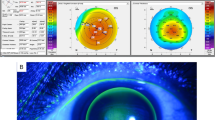Abstract
The purpose of this study was to investigate the efficacy and safety of the Toris K silicone hydrogel contact lens (SwissLens; Prilly, Switzerland) in keratoconus patients. A database with information on 50 keratoconus patients (64 eyes) fitted with Toris K soft contact lenses over a 2-year period was retrospectively reviewed. Demographic data, prefitting refraction, the reason for choosing the Toris K soft contact lens, uncorrected visual acuity (UCVA), best spectacle-corrected visual acuity (BSCVA), best-corrected visual acuity with a rigid gas permeable lens (BCVA RGP), best-corrected visual acuity with the Toris K lens (BCVA Toris K), and complications were evaluated. The mean age ± standard deviation at the time of fitting was 27.92 ± 9.86 years. The mean spherical refractive power was −4.62 ± 6.53 dioptres, and the mean cylinder was −3.78 ± 2.43 dioptres. The most common reason for using Toris K soft contact lenses was an inability to fit the patient with a RGP contact lens. There was a statistically significant difference between UCVA and BCVA Toris K (p = 0.0001), as well as between BSCVA and BCVA Toris K (p = 0.0001). However, there was no statistically significant difference between BCVA Toris K and BCVA RGP (p = 0.20). Superficial punctate keratitis and giant papillary conjunctivitis were the most common complications. The Toris K contact lens is a viable alternative for the optical management of all grades of keratoconus. The Toris K soft contact lens is a promising alternative for the visual rehabilitation of keratoconus patients who cannot tolerate RGP lenses or achieve a good fit.

Similar content being viewed by others
References
Krachmer JH, Feder RS, Belin MW (1984) Keratoconus and related noninflammatory corneal thinning disorders. Surv Ophthalmol 28:293–322
Rabinowitz YS (1998) Keratoconus. Surv Ophthalmol 42:297–319
Efron N, Hollingsworth JG (2008) New perspectives on keratoconus as revealed by corneal confocal microscopy. Clin Exp Optom 91:34–55
Barnett M, Mannis MJ (2011) Contact lenses in the management of keratoconus. Cornea 30:1510–1516. doi:10.1097/ICO.0b013e318211401f
Lass JH, Lembach RG, Park SB, Hom DL, Fritz ME, Svilar GM et al (1990) Clinical management of keratoconus: a multicenter analysis. Ophthalmology 97:433–445
Asbell PA, Dunn MJ (1997) Fitting the abnormal cornea. In: Krachmer JH, Mannis MJ, Holland EJ (eds) Cornea: diagnosis and management. Mosby-Year Book Inc, St. Louis, pp 1457–1460
Barr JT, Wilson BS, Gordon MO, Rah MJ, Riley C, Kollbaum PS et al (2006) Estimation of the incidence and factors predictive of corneal scarring in the Collaborative Longitudinal Evaluation of Keratoconus (CLEK) Study. Cornea 25:16–25
Bergmanson JP, Ruben M, Chu LW (1984) Corneal epithelial response of the primate eye to gas permeable corneal contact lenses: a preliminary report. Cornea 3:109–113
Efron N (2007) Contact lens-induced changes in the anterior eye as observed in vivo with the confocal microscope. Prog Retin Eye Res 26:398–436
Owens H, Watters G, Gamble G (2002) Effect of SoftPerm lens wear on corneal thickness and topography: a comparison between keratoconic and normal corneas. CLAO J 28:83–87
Edmonds CR, Wung SF, Husz MJ, Pemberton B (2004) Corneal endothelial cell count in keratoconus patients after contact lens wear. Eye Contact Lens 30:54–58
Giasson CJ, Perreault N, Brazeau D (2001) Oxygen tension beneath piggyback contact lenses and clinical outcomes of users. CLAO J 27:144–150
Belin MW, Ambrósio R (2013) Scheimpflug imaging for keratoconus and ectatic disease. Indian J Ophthalmol 61:401–406
Kamiya K, Ishii R, Shimizu K, Igarashi A (2014) Evaluation of corneal elevation, pachymetry and keratometry in keratoconic eyes with respect to the stage of Amsler-Krumeich classification. Br J Ophthalmol 98:459–463
Keratoconus soft contact lenses, in: SwissLens product document, 2012, pp. 16–17
Fatima T, Acharya MC, Mathur U, Barua P (2010) Demographic profile and visual rehabilitation of patients with keratoconus attending contact lens clinic at a tertiary eye care centre. Cont Lens Anterior Eye 33:19–22. doi:10.1016/j.clae.2009.09.004
Chou B, Weissman BA (2010) Making sense of the irregular cornea. Rev Cornea Cont Lenses 147:14–21
González-Méijome JM, Jorge J, De Almeida JB, Parafita MA (2006) Soft contact lenses for keratoconus: case report. Eye Contact Lens 32:143–147
Uçakhan OO, Bayraktutar B (2014) KeraSoft 3 contact lenses in corneal ectasia. Eye Contact Lens 40:390–394. doi:10.1097/ICL.0000000000000092
Fernandez-Velazquez FJ (2012) Kerasoft IC compared to Rose-K in the management of corneal ectasias. Cont Lens Anterior Eye 35:175–179. doi:10.1016/j.clae.2012.02.005
Yavuz L, Yilmaz I, Özgür OR, Kandemir B, Calli U, Cabi C (2013) Toris K silicone hydrogel contact lens for the optical management of keratoconus. New J Med 30:174–176
Gumus K, Kahraman N (2015) A New Fitting Approach for Providing Adequate Comfort and Visual Performance in Keratoconus: Soft HydroCone (Toris K) Lenses. Eye Contact Lens, 1–6
Forister JF, Forister EF, Yeung KK, Ye P, Chung MY, Tsui A et al (2009) Prevalence of contact lens-related complications: UCLA contact lens study. Eye Contact Lens 35:176–180
Altun A, Kurna SA, Sengor T, Altun G, Olcaysu OO, Simsek MH (2015) Success of hydrocone (TORIS-K) soft contact lens for keratoconus and traumatic keratopathy. Pak J Med Sci 31:995–998
Funding
There is no funding was received.
Author information
Authors and Affiliations
Corresponding author
Ethics declarations
Conflicts of Interest
The authors declare that there is no conflict of interest.
Rights and permissions
About this article
Cite this article
Sultan, P., Dogan, C. & Iskeleli, G. A retrospective analysis of vision correction and safety in keratoconus patients wearing Toris K soft contact lenses. Int Ophthalmol 36, 799–805 (2016). https://doi.org/10.1007/s10792-016-0200-0
Received:
Accepted:
Published:
Issue Date:
DOI: https://doi.org/10.1007/s10792-016-0200-0




